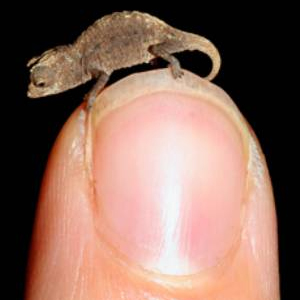Biologist Discovers Mini Reptile
SDSU's Ted Townsend conducted genetic tests that confirmed the lizard is an ancient and previously unknown chameleon species.

Brookesia micra is the smallest chameleon species ever discovered, and is in close competition with some species of West Indian gecko as the world’s smallest reptile.
A team of four researchers, including Ted Townsend, biology professor at San Diego State, discovered and described B. micra along with three other new species of chameleons within the Brookesia minima group. The team’s findings were published in a recent issue of the journal PLoS ONE.
The genus Brookesia, known collectively as leaf chameleons, already contained some very small species. Researchers discovered the smallest of the four new species, B. micra, on the tiny islet of Nosy Hara off the north coast of Madagascar.
The joint project, led by Frank Glaw of the Bavarian State Collection of Zoology in Germany and supported by Townsend, Jorn Kohler and Miguel Vences, found the species to represent a case of miniaturization, an outcome common in some island populations.
About the chameleon
Brookesia micra measures less than 30 millimeters fully grown and juveniles can stand comfortably atop the head of a match. Like other leaf chameleons, B. micra is a drab brown and cannot change colors like its larger and more familiar cousins.
Their tiny size made distinguishing the lizards particularly difficult, and researchers used careful anatomic studies and genetic analyses to determine that they were separate species. Researchers in Germany conducted morphological studies, and Townsend, located in San Diego, conducted genetic analyses on the tissue samples.
Townsend is quick to point out that the Brookesia leaf chameleons, along with at least one group of morphologically similar ground chameleons from the African mainland, diverged very early in chameleon evolutionary history.
“This suggests that, although these small, drab, and cryptic species are not what come to mind when most people think of typical chameleons,” Townsend said, "and they may in fact more closely resemble the ancestral proto-chameleon than the larger and often brilliantly colored species so familiar to us all.”
On the trail
Researchers Glaw, Kohler and Vences searched for the leaf chameleons at night, and while finding them was difficult, they were not nearly as difficult to catch.
They are active during the day and climb into “trees” four inches off the ground to sleep at night, Glaw said, and while sleeping, they are very easy to catch — “you just pick them up.”
Some of the newly found species have tiny distributions just a few square miles in size, making them extremely threatened by extinction due to deforestation and habitat loss.
Ted Townsend's contribution to the discovery of Brookesia micra is one of many ways SDSU faculty are leading innovation and discovery, a key initiative of The Campaign for SDSU. With a unique focus on the teacher-scholar model, SDSU attracts researchers interested in solving the world’s most pressing problems, while showing students how to provide future solutions.
Using DNA
When the field researchers found B. micra and the other unique new specimens, they sent tissue samples to Townsend, who then isolated and sequenced the DNA to determine the evolutionary history of these lizards.
His analyses confirmed that each sampled population was a distinct species. More striking still, Townsend said, the DNA revealed that these superficially very similar species were actually quite ancient and each had diverged from the others 10 to 20 million years ago.
“It really is amazing to be part of something like this — discovering what could be the smallest lizard in the world,” said Townsend. “These chameleons are fascinating creatures.”
The discoveries were made during a series of expeditions to Madagascar from 2002 to 2007, and Glaw has been studying Madagascar for more than 25 years. These creatures may represent the smallest examples of species miniaturization, said Glaw, but it is impossible to know if there isn’t another, smaller, chameleon yet undiscovered.



